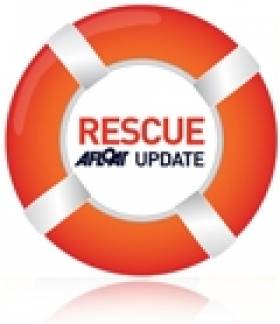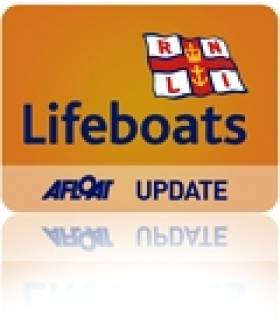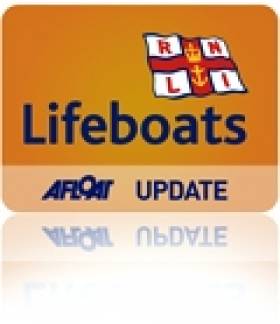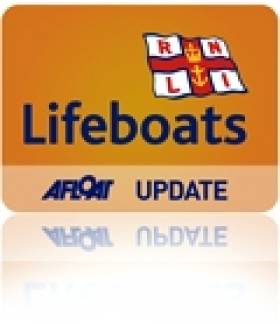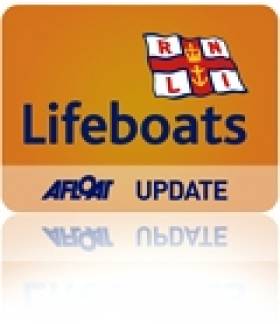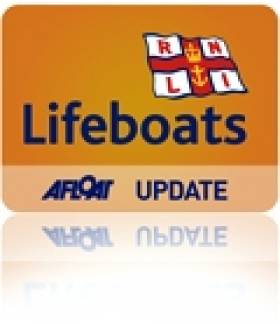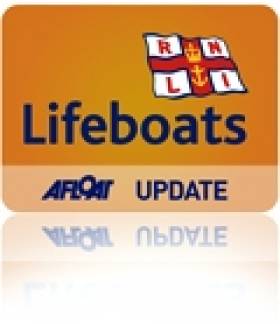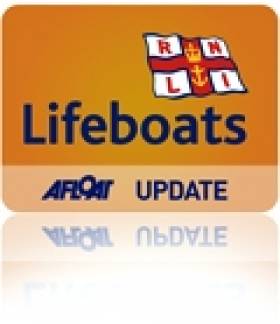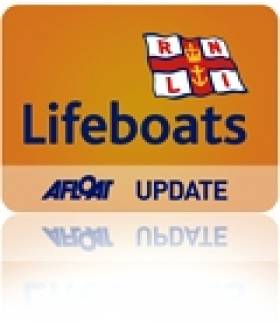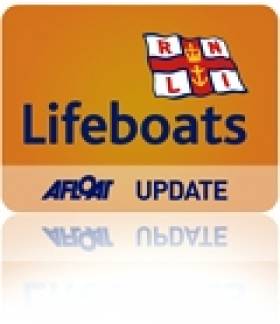Displaying items by tag: Lifeboats
Man Rescued Sailing To America In Flimsy Dinghy
#Rescue - Lifeboat volunteers on the Dorset coast went to the rescue of a man attempting to sail to America in a 14ft dinghy, as NewsTalk.ie reports.
Mudeford RNLI were launched after reports from a passing yacht that had concerns about the solo offshore boater.
On arrival, the lifeboat crew found the Bulgarian national on the dinghy was "exceedingly cold, wet and violently ill" yet was refusing their assistance.
They soon ascertained that the 30-year-old man, who has a US visa, had bought the dinghy earlier that day, packed it with some meagre supplies – without any suitable safety equipment or navigation aids – and set out to cross the Atlantic.
"He would have died [if we left him there," said lifeboat crewman Pete Dadds. "He was severely sea sick, he had the first signs of hypothermia and his boat was filling up with water."
NewsTalk.ie has more on the story HERE.
Lough Derg Lifeboat Assists Five On Broken-Down Boat
#RNLI - At 7.25pm on Saturday evening (16 August) Valentia Coast Guard requested Lough Derg RNLI to launch to assist five people on board a vessel reported broken down soon after setting out from Garrykennedy Harbour to Mountshannon Harbour.
The lifeboat launched at 7.35pm with helm Eleanor Hooker, David Moore and Jason Freeman on board. Winds were southwestly Force 6 and visibility was good.
At 7.50pm the lifeboat located the casualty vessel between Parker Point and Garrykennedy, and found all on board – four adults and a child – to be safe and wearing their lifejackets.
An RNLI crewmember was transferred across, where he reassured the passengers before setting up a tow. The lifeboat then towed the boat back to Garrykennedy, where it was safely tied up alongside at 8.10pm.
The skipper of the cruiser thanked the RNLI crew for their speedy assistance. He said that he had raised the alarm "as with the worsening weather and no boats visible to offer him assistance, I was getting very concerned."
The lifeboat crew assured him that he had done the correct thing in calling for help.
Arranmore Lifeboat On All-Night Callout To Stranded Yacht
#RNLI - Arranmore RNLI lifeboat crew had a long callout in the early hours of this morning to a 30ft yacht in trouble off Gola Island.
The pagers went off just before 2am, when the lifeboat crew – along with their Donegal coastal colleagues from Bunbeg Coast Guard – were called out to assist the yacht, with a father and son on board, that had dragged its anchor and got stuck on rocks at Gola Island.
Once on scene a tow was quickly established between the yacht and the Arranmore all-weather lifeboat. But with the tide out it proved too dangerous to try and move the yacht, and both rescue crews waited on scene with the vessel until the water rose and it was safe to try and move the stricken yacht.
At 4:50am a successful attempt was made to move the yacht and the tow to Burtonport commenced. When coming along Owey Sound, however, it was apparent that the rudder on the yacht was broken and great care had to be taken to keep the vessel on course.
Weather conditions were Force 5 to 6 with a north-westerly wind blowing. The shelter of Gola made the tow quite smooth initially, but on leaving the area conditions deteriorated and it was a difficulty passage for the remaining journey.
Commenting on the callout, Arranmore RNLI coxswain Anton Kavanagh said: "Thankfully both father and son [on the yacht] sustained no injuries. Due to the weather conditions the yacht was very lucky to receive only minor damage."
Skerries RNLI Raft Race Set For September
#RNLI - The annual raft race in aid of Skerries RNLI, which has been growing in popularity since its return two years ago, will take place on Saturday 13 September.
The raft race is a great day out for all the family, and the fundraising committee is hard at work to ensure the event is an even bigger success this year. The venue will, as before, be the south strand in Skerries.
Registration for the race will take place at the Skerries RNLI station house on the Harbour Road in Skerries on Sunday 7 September from 2pm to 4pm. The entry fee will be €50 per raft and each raft must be crewed by four to six people.
Lifejackets are mandatory for the event. Mechanical propulsion systems are not allowed and the entry must be a raft. Surfboards, boats, carved foam, etc will be disqualified. All competitors must be over 18.
Speaking ahead of the event, Skerries RNLI volunteer lifeboat press officer Gerry Canning said: "The raft race is a great attraction to everyone young and old. Every year the competitors outdo themselves with their creations and we are looking forward to more of the same this year."
Keep an eye on the Skerries RNLI website for regular updates, so keep an eye on the website, as well as the Skerries RNLI Facebook page and Twitter account @SkerriesRNLI.
Howth Lifeboats Respond To Five Callouts In Five Days
#RNLI - Sunday's aid of a fishing trawler with a fouled propeller near Lambay Island was just one of five callouts or the volunteers at Howth RNLI within five days, marking one of the busiest seasons for the North Co Dublin crew.
These callouts were mainly to vessels that had developed problems while at sea and the lifeboats were called to assist and tow them to safety.
The first was on Saturday 9 August, when Howth’s inshore lifeboat was launched at 10.30am to locate and assist a motorboat that had started to take on water and was trying to make its way back to Howth Marina. The lifeboat crew escorted the vessel safely back to the harbour.
On Sunday evening, following the all-weather lifeboat's fishing trawler rescue previously reported on Afloat.ie, the inshore lifeboat was launched as darkness fell to assist a vessel which had run out of fuel outside Howth Harbour.
The motorboat, with three people aboard, was located and towed back to the public slipway where the motorboat had departed from earlier that day.
More recently, yesterday (Wednesday 13 August) the all-weather lifeboat launched at 1.40pm to tow a sailing vessel with steering problems back to the harbour.
The 43-foot sailing yacht, with three people aboard, was taken in tow and brought to Howth Marina.
Later in the evening, the all-weather lifeboat was again launched to assist a motorboat with engine problems to the north west of Ireland’s Eye. The vessel was quickly located and towed back to Howth Harbour.
“It has been a particularly busy time in Howth for both our lifeboats," said Howth RNLI volunteer lifeboat crew member David Howard, "but we are pleased that all our recent callouts resulted in no injury and all casualty vessels were safely towed back to Howth Harbour.
"All the vessels had means of contacting the shore and we compliment the skippers of the boats in not hesitating to call for help at the first sign of difficulties.”
Howth Lifeboat Tows Fishing Trawler To Safety
#RNLI - Howth RNLI's all-weather lifeboat launched at 1.20pm yesterday afternoon (10 August) to reports of a fishing trawler with a fouled propeller drifting north-east of Lambay Island.
Skerries RNLI's volunteer crew also launched their Atlantic 85 lifeboat Louis Simson, but were stood down when it became clear that Howth's Trent-class lifeboat was more apt for the job.
The Howth lifeboat crew located the casualty vessel at 2pm some 12 miles north-east of Howth and established a tow line within 10 minutes of arrival.
The fishing vessel was then safely towed back to Howth Harbour, though progress was slow as a result of deteriorating weather conditions – with a north-west Force 6 wind and a rough sea state – and the return journey took just over two hours.
Howth RNLI coxswain Fred Connolly said after the callout: "We were pleased to locate and assist the fishing trawler so quickly after receiving the call to launch.
"The fishing vessel crew acted very professionally in calling for assistance immediately and they also supplied a accurate position of their location which allowed us to find and assist them so quickly."
Gerry Canning, volunteer lifeboat press officer for Skerries RNLI, added: "The RNLI has a wide range of boats in the fleet to cater for all types of emergencies in all conditions. In this case the Trent all-weather lifeboat from Howth was definitely the right boat for the rescue."
Bundoran Lifeboat Rescues Surfer In Difficulty
#RNLI - A surfer got into difficulty on Saturday evening (9 August) at Tullan Strand in Bundoran and was being swept out to sea when a member of the public spotted the situation and called the emergency services.
Two other surfers went to his aid while the pagers of the volunteer crew of the Bundoran lifeboat were set off at 6.05pm, five minutes later the lifeboat was in the water proceeding at full speed to the scene.
Arriving at Tullan Strand, the three surfers from Dublin were quickly located with the help of RNLI shore crew who had been deployed by land. The lifeboat took all three on board and proceeded back to the lifeboat station.
The casualty had taken on a lot of water and had oxygen administered to him on his return to the lifeboat station, where a waiting ambulance transferred him to Sligo General Hospital for further observation.
Bundoran RNLI volunteer crewman Brian Faulkner said: "Once again we are thankful to a member of the public who called the coastguard and made the alert.
"A lot more people are using the water in these good weather conditions and we’d like to remind everyone to be safe in the knowledge that if they do get into trouble in the water that we are on call 24 hours a day, seven days a week.
"Call 999 or 112 and ask for the coastguard if you see anyone in difficulty in the water or on the coast."
Meanwhile, a boat at anchor caused the volunteer crew of Bundoran RNLI to launch again yesterday evening (10 August) just after 8.30pm.
The boat had been spotted near Mermaid’s Cove at Mullaghmore with nobody on board and had caused concern, prompting the lifeboat to launch and check it out.
On reaching the scene, the crew of the lifeboat found that another boat had commenced towing the anchored boat. However, the towing boat had fouled its prop and they themselves then required assistance to get back to the harbour.
The lifeboat crew duly obliged and took the boat under tow and the four persons on board back to the harbour. The initial boat was also tied up.
"We were in the right place at the right time," said volunteer RNLI helm Kealan McNulty. "There was no immediate danger but we were happy to be on hand and help out."
Clifden RNLI Now Trialling All-Weather Lifeboat
#RNLI - Clifden RNLI has put an all-weather lifeboat on service for a trial period, more than a year after the move was confirmed.
The Pride and Spirit has come from the existing RNLI fleet and will be on trial for 12 months operating in conjunction with the existing inshore lifeboat service at the station.
Following the trial, the RNLI will make the call on establishing a permanent all-weather lifeboat service for Connemara's largest town.
A decision was made back in April 2012 by the charity’s trustees, with the recommendation of its operations committee, that the volunteer crew at Clifden would take delivery of a carriage launched Mersey-class lifeboat, following an in-depth review of lifeboat cover in the area.
Since that announcement, there has been an intensive period of preparation for the volunteer lifeboat crew, which has included months of training at Clifden and visits to the RNLI College in Poole.
There are currently four coxswains, four mechanics, four navigators and 16 all-weather lifeboat crew trained and ready to respond to call outs aboard the Pride and Spirit.
Clifden RNLI lifeboat operations manager John Brittain said he is proud of the additional lifeboat service at the West Co Galway station.
"This is a great day for everyone involved with Clifden RNLI. The new lifeboat will allow us to provide lifesaving cover in all weathers up to 100 miles off the Connemara coast.
"We have received great support and encouragement from everyone involved with the RNLI at both Swords and Poole. To see this group of volunteers coming together and training with the all-weather lifeboat and now going on service is a proud day for us all."
RNLI divisional operations manager Owen Medland added: "Since the announcement back in April 2012, the enthusiasm at the station has been wonderful and I am delighted that after months of training, the volunteer crew now has an all-weather lifeboat on service.
"We are continuing to work hard to establish a temporary shore facility which shall allow us to maintain Pride and Spirit ashore."
All-weather lifeboats can be operated safely in all-weather while inshore lifeboats usually operate closer to shore, in shallower water, close to cliffs, among rocks or even in caves.
Introduced as the RNLI’s first fast-carriage lifeboat, the Mersey class has a top speed of 17 knots. Designed to operate from a carriage, slipway or lie afloat, this class of lifeboat is also capable of being self-righted in challenging conditions.
The Mersey, which carries a lifeboat crew of six, has been in service for many years and shall eventually be replaced by the new Shannon-class lifeboat.
Last year, Clifden RNLI launched eight times bringing seven people to safety. Of those launches, two services were in the dark. In all, some 82 service hours were spent at sea.
A lifeboat station was established in Clifden in early 1988, and the station currently operates two inshore lifeboats.
Skerries Lifeboat Searches For 'Missing' Fisherman
#RNLI - Volunteers with Skerries RNLI launched their Atlantic 85 lifeboat Louis Simson shortly after 8.30pm on Tuesday evening (5 August) after a member of the public called Dublin Coast Guard regarding a man seen launching a small motor boat to go fishing that afternoon who had yet to return.
The lifeboat, with David Knight at the helm and crewed by Joe May, Eoin Grimes and Stephen Crowley, began an immediate search of the most popular local fishing spots, while other volunteer crew in the boathouse began to chart a potential search pattern.
A small motorboat matching the description given, with one man on board, was located just off the western shore of Church Island, off Skerries. The man required no assistance and indicated he was preparing to head for the North Co Dublin coastal town.
As the light was fading the lifeboat offered to stand by while he made his way safely to shore. At the time of the launch there was a Force 2 to 3 southerly wind and a calm sea.
Speaking after the callout, volunteer helm David Knight said: "Thankfully in this case the man was fine. However, the member of the public had genuine concerns and did the right thing in calling the coastguard."
Bundoran Lifeboat Launched To Family Trapped On Rocks
#RNLI - The volunteer crew of the Bundoran RNLI lifeboat were paged by Malin Head Coastguard yesterday afternoon (Wednesday 6 August) to a family of four who were trapped on rocks near Tullan Strand at the Co Donegal town.
A member of the public who heard the family calling for help phoned 112 to alert the Irish Coast Guard, who quickly paged the lifeboat at 5.49pm.
Within minutes of the alert, the Bundoran lifeboat launched and was quickly on scene. However, the water was too shallow to bring the boat closer to the family.
Shortly afterwards the Sligo-based coastguard helicopter Rescue 118 arrived, winching the family into the helicopter and lowering them onto the beach, where they were met by members of the RNLI shore crew.
"The situation may have been much worse had the member of the public not heard the shouts for help," said Bundoran RNLI helm Dessie Daly.
"We are thankful that they made the quick decision to call the emergency services and get us launched."


























